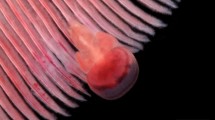Abstract
In September 2018, polychaeta worms of the family Sabellidae—Laonome xeprovala Bick & Bastrop, 2018—were found in the Luga Bay (Gulf of Finland, Baltic Sea). This species was previously been recorded in Europe, but the eastern most point of its discovery was the Gulf of Wislin—the southeastern region of the Baltic Sea. The article presents the main morphological description and distribution of this species in the investigated area.



Similar content being viewed by others
REFERENCES
Bick, A., Bastrop, R., Kotta, J., Meisner, K., Meyer, M., and Syomin, V., Description of a new species of Sabellidae (Polychaeta, Annelida) from fresh and brackish waters in Europe, with some remarks on the branchial crown of Laonome, Zootaxa, 2018, vol. 4483, no. 2, рр. 349–364. https://doi.org/10.11646/zootaxa.4483.2.7
Boltachova, N.A., Lisitskaya, E.V., Frolenko, L.N., Kovalev, E.A., and Brabashin, T.O., The finding of polychaete Laonome calida Capa, 2007 (Annelida: Sabellidae) in the southeast Sea of Azov, Russ. J. Biol. Invasions, 2017, vol. 8, no. 4, рр. 203–306. https://doi.org/10.1134/S2075111717040026
Capa, M., Taxonomic revision and phylogenetic relationships of apomorphic sabellids (Sabellidae: Polychaeta) from Australia, Invertebr. Syst., 2007, vol. 21, рр. 537–567.https://doi.org/10.1071/IS07002
Capa, M., van Moorsel, G., and Tempelman, D., The Australian feather-duster worm Laonome calida Capa, 2007 (Annelida: Sabellidae) introduced into European inland waters? BioInvasions Rec., 2014, vol. 3, pp. 1–11.
Ekologicheskie aspekty dredzhinga (Environmental Safety of Dreading), Brey, R.N., Ed., St. Petersburg, 2013.
Gherardi, F., Bioinvasions in fresh waters and the nero dilemma, Pol. J. Ecol., 2006, no. 4, рр. 549–561.
Gherardi, F., Crayfish as global invaders: distribution, impact on ecosystem services and management options, J. Astocol. Freshwater Crayfish, 2013, vol. 19, no. 2, рр. 177–187.
Grant, V., Organismic Evolution, San Francisco, 1977.
Kocheshkova, O.V., Polychaetes of the Vistula Bay (Baltic Sea): species composition and adaptation to the conditions of a eutrophic brackish lagoon, Extended Abstract of Cand. Sci. (Biol.) Dissertation, Murmansk, 2017.
Kocheshkova, O.V. and Ezhova, E.E., On alien polychaete species of the Russian part of South-Eastern Baltic, Mar. Biol. J., 2018, vol. 3, no. 2, рр. 53–63.https://doi.org/10.21072/mbj.2018.03.2.04
Kotta, J., Kotta, I., Bick, A., Bastrop, R., and Väinölä, R., Modelling habitat range and seasonality of a new, non-indigenous polychaete Laonome sp. (Sabellida, Sabellidae) in Pärnu Bay, the north-eastern Baltic Sea, Aquat. Invasions, 2015, vol. 10, no. 3, рр. 275–285.https://doi.org/10.3391/ai.2015.10.3.03
Lyakhin, Yu.I., Makarova, S.V., Maximov, A.A., Savchuk, O.P., and Silina, N.I., Ecological situation in the eastern part of the Gulf of Finland in July 1996, in Problemy issledovaniya i matematicheskogo modelirovaniya ekosistemy Baltiiskogo moray, Vyp. 5: Ekosistemnye modeli. Otsenka sovremennogo sostoyaniya Finskogo zaliva, Ch. 2: Gidrometeorologicheskie, gidrokhimicheskie, gidrobiologicheskie, geologicheskie usloviya i dinamika vod Finskogo zaliva (Problems of Research and Mathematical Modelling of the Baltic Sea Ecosystem, Vol. 5: Ecosystem Models. Assessment of the Current State of the Gulf of Finland, Ch. 2: Hydrometeorological, Hydrochemical, Hydrobiological, and Geological Conditions and Dynamics of Waters in the Gulf of Finland), St. Petersburg: Gidrometeoizdat, 1997, рр. 416–434.
Maximov, A.A., Large-scale invasion of Marenzelleria spp. (Polychaeta, Spyonidae) in the Eastern Gulf of Finland (Baltic Sea), Russ. J. Biol. Invasions, 2011, vol. 2, no. 1, pp. 11–19.
Maximov, A.A., Mezhgodovaya i mnogoletnyaya dinamika makrozoobentosa na primere vershiny Finskogo zaliva (Interannual and Long-Term Dynamics of Macrozoobenthos on the Example of the Gulf of Finland Peak), St. Petersburg: Nestor-Istoriya, 2018.
Metodicheskie rekomendatsii po sboru i obrabotke materialov pri gidrobiologicheskikh issledovaniyakh na presnovodnykh vodoemakh. Zoobentos i ego produktsiya (Methodological Recommendations for Collection and Processing of Materials in Hydrobiological Studies on Fresh Water Bodies. Zoobenthos and Its Production), Leningrad, 1983.
Millennium Ecosystem Assessment. Ecosystems and Human Well-Being: Biodiversity Synthesis, Washington: World Resources Inst., 2005.
Pabis, K., Krodkiewska, M., and Cebulska, K., Alien freshwater polychaetes Hypania invalida (Grube 1860) and Laonome calida Capa 2007 in the upper Odra River (Baltic Sea catchment area), Knowl. Manag. Aquat. Ecosyst., 2017, vol. 418, pp. 46. https://doi.org/10.1051/kmae/2017033
Resursy poverkhnostnykh vod SSSR, Tom 2: Kareliya i Severo-Zapad (Surface Water Resources of the USSR, Vol. 2: Karelia and the Northwest), Vodogretskii, V.E., Ed., Leningrad: Gidrometeoizdat, 1972, part 1.
Susloparova, O.N., Titov, S.F., Maksimova, O.B., Zuev, Yu.A., and Khozyaikin, A.A., On the determination the fishery significance of areas in the Gulf of Finland, Mater. XII Mezhd. ekol forum “Den’ Baltiiskogo morya” (Proc. Int. Environ. Forum “The Day of the Baltic Sea”), St. Petersburg, 2011, рр. 123–125.
Syomin, V.L., Kovalenko, E.P., and Savikin, A.I., Aracia sp. (Polychaeta: Sabellidae) from the Don River estuary (Sea of Azov basin), Russ. J. Biol. Invasions, 2015, vol. 6, no. 1, рр. 65–67.https://doi.org/10.1134/S2075111715010075
ACKNOWLEDGMENTS
We are deeply grateful for the help of the staff of the Zoological Institute, Russian Academy of Sciences, E.N. Egorova, A.A. Maximov, and B.I. Sirenko and to D.V. Bogdanov of the St. Petersburg Branch of VNIRO (GosNIORKh named after L.S. Berg).
Funding
This work was carried out in the framework of the state program “Implementation of State Monitoring of Aquatic Biological Resources in Inland Sea Waters of the Russian Federation, on the continental shelf of the Russian Federation, and in the exclusive economic zone of the Russian Federation, in the Sea of Azov and the Caspian Sea” and work on the state theme “Fauna, Ecology, and Biogeography of Invertebrate Hydrosphere” no. AAAA-A17-117030310207-3.
Author information
Authors and Affiliations
Corresponding authors
Ethics declarations
CONFLICT OF INTEREST
The authors declare that they have no conflict of interest.
COMPLIANCE WITH ETHICAL STANDARDS
The article does not contain any studies involving animals in experiments performed by any of the authors.
Rights and permissions
About this article
Cite this article
Tamulyonis, A.Y., Gagaev, S.Y., Stratanenko, E.A. et al. Invasion of the Polychaeta Laonome xeprovala Bick & Bastrop, 2018 (Sabellidae, Polychaeta) into the Estuary of the Luga and Khabolovka Rivers (Luga Bay, Gulf of Finland). Russ J Biol Invasions 11, 148–154 (2020). https://doi.org/10.1134/S2075111720020113
Received:
Revised:
Accepted:
Published:
Issue Date:
DOI: https://doi.org/10.1134/S2075111720020113




